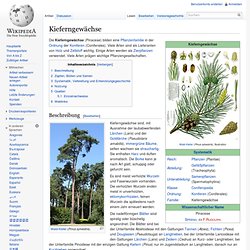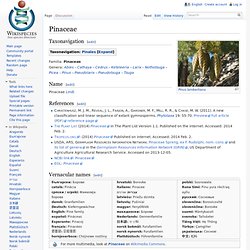

Kieferngewächse. Beschreibung[Bearbeiten] Die größten bekannten Bäume der Familie sind Douglasien: „Red Creek Fir“ (Pseudotsuga menziesii) mit einer Wuchshöhe von 73,8 Meter bei einem Stammdurchmesser BHD von 4,02 Meter[1] auf Vancouver Island.

Ähnlich groß können Sitka-Fichten werden: Picea sitchensis mit Wuchshöhen von bis zu 70 Metern bei Stammdurchmessern von etwa 3 Metern im Queets River Tal des Olympic National Park. Die mit über 4000 Jahren ältesten bekannten Kieferngewächse sind Pinus longaeva. Zapfen, Blüten und Samen[Bearbeiten] Alle Arten der Kieferngewächse sind einhäusig getrenntgeschlechtig (monözisch). Pinaceae. [edit] Familia: Pinaceae Genera: Abies – Cathaya – Cedrus – Keteleeria – Larix – Nothotsuga – Picea – Pinus – Pseudolarix – Pseudotsuga – Tsuga Name[edit] Pinaceae Lindl.

Pinaceae. Pinaceae. They are trees (rarely shrubs) growing from 2 to 100 m tall, mostly evergreen (except Larix and Pseudolarix, deciduous), resinous, monoecious, with subopposite or whorled branches, and spirally arranged, linear (needle-like) leaves.

The female cones are large and usually woody, 2-60 cm long, with numerous spirally arranged scales, and two winged seeds on each scale. The male cones are small, 0.5-6 cm long, and fall soon after pollination; pollen dispersal is by wind. Seed dispersal is mostly by wind, but some species have large seeds with reduced wings, and are dispersed by birds. Analysis of Pinaceae cones reveals how selective pressure has shaped the evolution of variable cone size and function throughout the family. Variation in cone size in the family has likely resulted from the variation of seed dispersal mechanisms available in the environment over time.